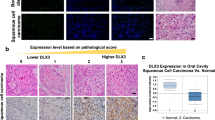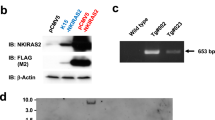Abstract
Approximately 1,000,000 epithelial skin cancers are diagnosed in the United States each year and most are basal cell carcinomas (BCCs). The pathogenesis of these tumours involves constitutive activation of the Sonic hedgehog (Shh) signalling pathway (for review, see ref. 1). In many BCCs this can be attributed to loss-of-function mutations of PTCH (refs 2,3), which encodes a SHH receptor and antagonist. The specific downstream effector in the Shh pathway leading to cancer development is unknown. Here we show that transgenic mice overexpressing the transcription factor Gli2 in cutaneous keratinocytes develop multiple BCCs. These results establish Gli2 as a potent oncogene in skin and suggest a pivotal role for this transcription factor in the development of human BCC.
This is a preview of subscription content, access via your institution
Access options
Subscribe to this journal
Receive 12 print issues and online access
$209.00 per year
only $17.42 per issue
Buy this article
- Purchase on Springer Link
- Instant access to full article PDF
Prices may be subject to local taxes which are calculated during checkout


Similar content being viewed by others
References
Booth, D.R. Cancer Metast. Rev. 18, 261–284 (1999).
Hahn, H. et al. Cell 85, 841–851 (1996).
Johnson, R.L. et al. Science 272, 1668–1671 (1996).
Matise, M.P. & Joyner, A.L. Oncogene 18, 7852–7859 (1999).
Dahmane, N., Lee, J., Robins, P., Heller, P. & Ruiz i Altaba, A. Nature 389, 876–881 (1997).
Hynes, M. et al. Neuron 19, 15–26 (1997).
Lee, J., Platt, K.A., Censullo, P. & Ruiz i Altaba, A. Development 124, 2537–2552 (1997).
Motoyama, J. et al. Nature Genet. 20, 54–57 (1998).
Ding, Q. et al. Development 125, 2533–2543 (1998).
Ramirez, A., Bravo, A., Jorcano, J.L. & Vidal, M. Differentiation 58, 53–64 (1994).
Markey, A.C., Lane, E.B., MacDonald, D.M. & Leigh, I.M. Br. J. Dermatol. 126, 154–160 (1992).
Smoller, B.R., van de Rijn, M., Lebrun, D. & Warnke, R.A. Br. J. Dermatol. 131, 28–31 (1994).
Oro, A.E. et al. Science 276, 817–821 (1997).
Xie, J. et al. Nature 391, 90–92 (1998).
Aszterbaum, M. et al. Nature Med. 5, 1285–1291 (1999).
Chiang, C. et al. Dev. Biol. 205, 1–9 (1999).
Acknowledgements
We thank S. Yuspa, P. Coulombe, D. Bol and J. Jorcano for reagents; L. Lowe, L. Su and T. Johnson for advice on tumour histology; L. Wei and M. Berard for preparing the transgenic mice; and E. Fearon, G. Cotsarelis, S. Egan, S. Morrison and J.T. Elder for constructive comments on the manuscript. C.-c.H. was partially supported by the National Cancer Institute of Canada. A.A.D was supported in part by the University of Michigan Comprehensive Cancer Center (NIH CA46592) and Center for Organogenesis.
Author information
Authors and Affiliations
Corresponding authors
Rights and permissions
About this article
Cite this article
Grachtchouk, M., Mo, R., Yu, S. et al. Basal cell carcinomas in mice overexpressing Gli2 in skin. Nat Genet 24, 216–217 (2000). https://doi.org/10.1038/73417
Issue Date:
DOI: https://doi.org/10.1038/73417
This article is cited by
-
The ULK3 kinase is a determinant of keratinocyte self-renewal and tumorigenesis targeting the arginine methylome
Nature Communications (2023)
-
Associations of keratinocyte cancers with snp variants in the sonic hedgehog pathway
BMC Cancer (2022)
-
Cellular Heterogeneity and Plasticity of Skin Epithelial Cells in Wound Healing and Tumorigenesis
Stem Cell Reviews and Reports (2022)
-
Human Skin Cancer: an Overview Of Animal, Ex Vivo, and In Vitro Models
Current Dermatology Reports (2022)
-
The emerging role of SPOP protein in tumorigenesis and cancer therapy
Molecular Cancer (2020)



